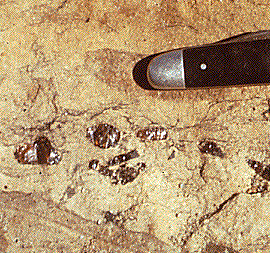Contents Amber
|
What is an amber ? This is another type of fossilization where the organism is entrapped
in a biologically inert environment and it is preserved wholly. For the
insects, which frequently occur in this type of fossilization, "chitinous
skeletons are little altered, but the soft inner tissues are missing." Amber is basically fossilized resin of a coniferous tree of early Tertiary (about 70 million years or so). According to Poinar, resin is "complex mixtures of terpenoid compounds, acids, and alcohols secreted from plant parenchyma." One of the differences between resin and sap is the latter's solubility in water since most of it is water from the xylem (water transporting system) of the tree. The process of amber formation Basically, organisms fall or drop into it when resin first exudes out of the tree due to its extreme stickiness. Oleoresins, essential oils, compose most of the first deposited resin. It is volatile and is usually lost through the years. Additional resin drops on top of it and gives the organism a typical suspended appearance. Then the resin hardens and becomes less vulnerable to destruction by the environment. Hardened resin has a higher chance of being fossilized since it can resist the environment better than pliable resin. The resin is hardened through a process called polymerization, where "small molecules (monomers) combine chemically to produce a large network of molecules." Hardened resin is called copal. This is one of the factor necessary to produce amber. As the copal ages, concentration of the essential oil decreases while the copal progressively oxidizes the resin and polymerization continues. The copal slowly turns into amber million years after the first entombment of the organism. The only way to differentiate between the two elements would be to put them through many physical and chemical tests such as UV light testing, burning, and various other tests. The most famous example is the amber from the Baltic Sea region (Germany, Poland, Lithuania, Denmark, the former Soviet Union, Great Britain, Estonia, Latvia, and Holland) where many organisms rarely found anywhere else in the world from the Oligocene epoch from the Tertiary period occurred here. Because of the presence of microscopic air bubbles, Baltic amber tend to appear cloudy or milky with the hue varying with quantity and quality of the microscopic air bubbles.
Index Amber || Casts & Molds || Compactions || Compressions || Coprolites & Gastroliths Drying & Dessication || Freezing || Impressions || Molecular Fossils || Permineralization
|
